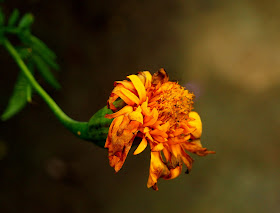Easily restored:
This is camia in the local term, Hedychium philippinense K. Schum. 1904 in The Plant List. I got mine originally from a province in the Visayas during my travels. It has a sweet scent that will fill your garden and reach your home in the early evening. That brings a bit of a mystical experience as dusk envelopes the surroundings.
Ours died during the last year's long dry season. We cannot provide the much needed water, so it totally died, rhizomes and all. It is easily restored because my sister has a young plant taken from it before it died. Her condition is much kinder, so i can easily ask for some rhizomes as replacement.
Moderately Easy to Restore:
Top and bottom photos are of Celosia gigantea. It was not around the garden for maybe 3 years now. The seeds totally were not able to make it to the next rainy season. In the past, after these annuals die, the seedlings just appear the coming rainy season, but in this case the dry season was very long and the seeds were not able to maintain germinability in the soil at the normal rate.
It is can be restored moderately easy if only i can see a plant anywhere and i can get a few seeds. They are just at the base of the flowers and can easily be scratched, germinate easily.The only problem is if i will not be able to see them anywhere on my daily walks or travels.
The pink, double Impatiens balsamina cannot be easily restored because just like the Celosia, it can also be restored if i fortunately come across it in my daily walks or travels. Or if the present violet and white varieties in my garden accidentally produced the pink, although that would only be single petals, OMG, please let me see another impatience pink double, haha!
This orange-throated gumamela also died last year's long dry season. So i included it to the moderately easy to restore. If i see it again in garden shows, then i can replace it.
This gaillardia had given me wonderful photographing moments. It has the most photogenic flowers i had for a few years. Every stages of the flower is a photographer's delight, and that includes every moment of the day. The hirsute bud, i also missed so much.
It was sent by a friend from the US, so it underwent a long acclimatization process. It received special watering treatments during our hot long dry season, but still it succumbed to the heat. Its genes cannot withstand it in the new environment. I hope someone from the US will send me some seeds again sometime. That is the only way this can be replaced. Thank you very much.
gaillardia
gaillardia
This is a Curcuma. Its leaves dry during the dry season and resurrect when the heavy rains come. The lovely part of its growth is that the spike above with the flowers emerge long before the leaves appear. Isn't that a wonderful garden accent if there are plenty of these growing on the ground?
However, last year's dry season we had house renovation, and some discarded roofs were piled on top of the ground. They didn't notice that there was this plant there because the leaves are totally dried. Eventually, the rhizomes rot because the roof was left there for a long time. I am so sorry, but that is an unusual circumstance, more like an emergency. So i will have to look for it again in the mountain where i previously got it. At least i know where to look for its natural habitat.






























